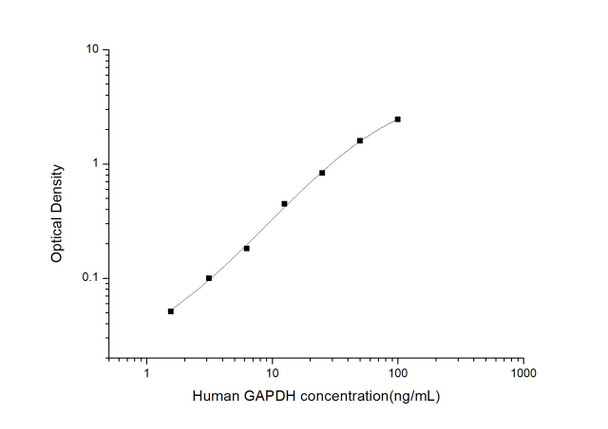Human Cell Death ELISA Kits
Human GAPDH (Glyceraldehyde-3-Phosphate Dehydrogenase) ELISA kit (HUES03219)
- SKU:
- HUES03219
- Product Type:
- ELISA Kit
- Size:
- 96 Assays
- Uniprot:
- P04406
- Sensitivity:
- 0.94ng/mL
- Range:
- 1.56-100ng/mL
- ELISA Type:
- Sandwich
- Synonyms:
- G3PDH,G3PD, GAPD
- Reactivity:
- Human
- Sample Type:
- Serum, plasma and other biological fluids
- Research Area:
- Cell Death
Description
| Assay type: | Sandwich |
| Format: | 96T |
| Assay time: | 4.5h |
| Reactivity: | Human |
| Detection Method: | Colormetric |
| Detection Range: | 1.56-100 ng/mL |
| Sensitivity: | 0.94 ng/mL |
| Sample Volume Required Per Well: | 100µL |
| Sample Type: | Serum, plasma and other biological fluids |
| Specificity: | This kit recognizes Human GAPDH in samples. No significant cross-reactivity or interference between Human GAPDH and analogues was observed. |
This ELISA kit uses Sandwich-ELISA as the method. The micro ELISA plate provided in this kit has been pre-coated with an antibody specific to Human GAPDH. Standards or samples are added to the appropriate micro ELISA plate wells and combined with the specific antibody. Then a biotinylated detection antibody specific for Human GAPDH and Avidin-Horseradish Peroxidase (HRP) conjugate are added to each micro plate well successively and incubated. Free components are washed away. The substrate solution is added to each well. Only those wells that contain Human GAPDH, biotinylated detection antibody and Avidin-HRP conjugate will appear blue in color. The enzyme-substrate reaction is terminated by adding Stop Solution and the color turns yellow. The optical density (OD) is measured spectrophotometrically at a wavelength of 450 nm ± 2 nm. The OD value is proportional to the concentration of Human GAPDH. The concentration of Human GAPDH in samples can be calculated by comparing the OD of the samples to the standard curve.
| UniProt Protein Function: | GAPDH: a multifunctional enzyme with both glyceraldehyde-3-phosphate dehydrogenase and nitrosylase activities. A key glycolytic enzyme that catalyzes the first step of the pathway by converting D-glyceraldehyde 3-phosphate (G3P) into 3-phospho-D-glyceroyl phosphate. An important enzyme for energy metabolism, and the production of ATP and pyruvate through anaerobic glycolysis in the cytoplasm. Additionally, it participates in apoptosis, membrane trafficking, iron metabolism, nuclear activities and receptor mediated cell signaling. Its subcellular localization changes reflecting its multiple activities. Is cytosolic, but is also localized in the membrane, the nucleus, polysomes, the ER and the Golgi. Participates in transcription, RNA transport, DNA replication and apoptosis. S-nitrosylation on Cys-152 following apoptotic stimulates its interaction with SIAH2, which in turn moderates its translocation into the nucleus. Mediates cysteine S-nitrosylation of nuclear target proteins including SIRT1, HDAC2 and DNA-PK. Deregulated in lung cancer, renal cancer, breast cancer, gastric cancer, glioma, liver cancer, colorectal cancer, melanoma, prostatic cancer, pancreatic cancer and bladder cancer. Its increased expression and enzymatic activity is associated with cell proliferation and tumorigenesis, Oxidative stress impairs GAPDH catalytic activity and leads to cellular aging and apoptosis. In experimental animal models, injection of GAPDH antagonists induces apoptosis and blocks Hep3B tumor progression, suggesting a therapeutic potential of targeting GAPDH in human hepatocellular carcinoma |
| UniProt Protein Details: | Protein type:Oxidoreductase; EC 1. 2. 1. 12; Carbohydrate Metabolism - glycolysis and gluconeogenesis Chromosomal Location of Human Ortholog: 12p13 Cellular Component: microtubule cytoskeleton; nuclear membrane; membrane; intracellular membrane-bound organelle; perinuclear region of cytoplasm; cytoplasm; plasma membrane; lipid particle; cytosol; ribonucleoprotein complex; nucleus; vesicle Molecular Function:identical protein binding; protein binding; microtubule binding; glyceraldehyde-3-phosphate dehydrogenase (phosphorylating) activity; NADP binding; NAD binding Biological Process: neuron apoptosis; glycolysis; protein stabilization; negative regulation of translation; carbohydrate metabolic process; glucose metabolic process; pathogenesis; microtubule cytoskeleton organization and biogenesis; gluconeogenesis |
| NCBI Summary: | This gene encodes a member of the glyceraldehyde-3-phosphate dehydrogenase protein family. The encoded protein has been identified as a moonlighting protein based on its ability to perform mechanistically distinct functions. The product of this gene catalyzes an important energy-yielding step in carbohydrate metabolism, the reversible oxidative phosphorylation of glyceraldehyde-3-phosphate in the presence of inorganic phosphate and nicotinamide adenine dinucleotide (NAD). The encoded protein has additionally been identified to have uracil DNA glycosylase activity in the nucleus. Also, this protein contains a peptide that has antimicrobial activity against E. coli, P. aeruginosa, and C. albicans. Studies of a similar protein in mouse have assigned a variety of additional functions including nitrosylation of nuclear proteins, the regulation of mRNA stability, and acting as a transferrin receptor on the cell surface of macrophage. Many pseudogenes similar to this locus are present in the human genome. Alternative splicing results in multiple transcript variants. [provided by RefSeq, Nov 2014] |
| UniProt Code: | P04406 |
| NCBI GenInfo Identifier: | 120649 |
| NCBI Gene ID: | 2597 |
| NCBI Accession: | P04406. 3 |
| UniProt Secondary Accession: | P04406,P00354, Q53X65, E7EUT4, |
| UniProt Related Accession: | P04406 |
| Molecular Weight: | Calculated MW: 31kDa/36kDaObserved MW: 36kDa |
| NCBI Full Name: | Glyceraldehyde-3-phosphate dehydrogenase |
| NCBI Synonym Full Names: | glyceraldehyde-3-phosphate dehydrogenase |
| NCBI Official Symbol: | GAPDH |
| NCBI Official Synonym Symbols: | G3PD; GAPD; HEL-S-162eP |
| NCBI Protein Information: | glyceraldehyde-3-phosphate dehydrogenase; aging-associated gene 9 protein; peptidyl-cysteine S-nitrosylase GAPDH; epididymis secretory sperm binding protein Li 162eP |
| UniProt Protein Name: | Glyceraldehyde-3-phosphate dehydrogenase |
| UniProt Synonym Protein Names: | Peptidyl-cysteine S-nitrosylase GAPDH (EC:2. 6. 99. -) |
| UniProt Gene Name: | GAPDH |
| UniProt Entry Name: | G3P_HUMAN |
As the OD values of the standard curve may vary according to the conditions of the actual assay performance (e. g. operator, pipetting technique, washing technique or temperature effects), the operator should establish a standard curve for each test. Typical standard curve and data is provided below for reference only.
| Concentration (ng/mL) | O.D | Average | Corrected |
| 100 | 2.525 2.547 | 2.536 | 2.451 |
| 50 | 1.649 1.701 | 1.675 | 1.59 |
| 25 | 0.936 0.902 | 0.919 | 0.834 |
| 12.5 | 0.528 0.538 | 0.533 | 0.448 |
| 6.25 | 0.28 0.252 | 0.266 | 0.181 |
| 3.13 | 0.191 0.179 | 0.185 | 0.1 |
| 1.56 | 0.136 0.136 | 0.136 | 0.051 |
| 0 | 0.082 0.088 | 0.085 | -- |
Precision
Intra-assay Precision (Precision within an assay): 3 samples with low, mid range and high level Human GAPDH were tested 20 times on one plate, respectively.
Inter-assay Precision (Precision between assays): 3 samples with low, mid range and high level Human GAPDH were tested on 3 different plates, 20 replicates in each plate.
| Intra-assay Precision | Inter-assay Precision | |||||
| Sample | 1 | 2 | 3 | 1 | 2 | 3 |
| n | 20 | 20 | 20 | 20 | 20 | 20 |
| Mean (ng/mL) | 5.06 | 14.20 | 37.82 | 4.90 | 13.02 | 40.14 |
| Standard deviation | 0.31 | 0.63 | 1.20 | 0.25 | 0.53 | 1.33 |
| C V (%) | 6.13 | 4.44 | 3.17 | 5.10 | 4.07 | 3.31 |
Recovery
The recovery of Human GAPDH spiked at three different levels in samples throughout the range of the assay was evaluated in various matrices.
| Sample Type | Range (%) | Average Recovery (%) |
| Serum (n=5) | 88-99 | 93 |
| EDTA plasma (n=5) | 85-100 | 91 |
| Cell culture media (n=5) | 93-107 | 100 |
Linearity
Samples were spiked with high concentrations of Human GAPDH and diluted with Reference Standard & Sample Diluent to produce samples with values within the range of the assay.
| Serum (n=5) | EDTA plasma (n=5) | Cell culture media (n=5) | ||
| 1:2 | Range (%) | 90-105 | 99-113 | 97-109 |
| Average (%) | 96 | 105 | 103 | |
| 1:4 | Range (%) | 87-98 | 84-100 | 80-92 |
| Average (%) | 93 | 91 | 87 | |
| 1:8 | Range (%) | 87-101 | 85-101 | 87-102 |
| Average (%) | 93 | 92 | 94 | |
| 1:16 | Range (%) | 90-104 | 85-98 | 81-92 |
| Average (%) | 97 | 90 | 87 |
An unopened kit can be stored at 4°C for 1 month. If the kit is not used within 1 month, store the items separately according to the following conditions once the kit is received.
| Item | Specifications | Storage |
| Micro ELISA Plate(Dismountable) | 8 wells ×12 strips | -20°C, 6 months |
| Reference Standard | 2 vials | |
| Concentrated Biotinylated Detection Ab (100×) | 1 vial, 120 µL | |
| Concentrated HRP Conjugate (100×) | 1 vial, 120 µL | -20°C(shading light), 6 months |
| Reference Standard & Sample Diluent | 1 vial, 20 mL | 4°C, 6 months |
| Biotinylated Detection Ab Diluent | 1 vial, 14 mL | |
| HRP Conjugate Diluent | 1 vial, 14 mL | |
| Concentrated Wash Buffer (25×) | 1 vial, 30 mL | |
| Substrate Reagent | 1 vial, 10 mL | 4°C(shading light) |
| Stop Solution | 1 vial, 10 mL | 4°C |
| Plate Sealer | 5 pieces | |
| Product Description | 1 copy | |
| Certificate of Analysis | 1 copy |
- Set standard, test sample and control (zero) wells on the pre-coated plate and record theirpositions. It is recommended to measure each standard and sample in duplicate. Note: addall solutions to the bottom of the plate wells while avoiding contact with the well walls. Ensuresolutions do not foam when adding to the wells.
- Aliquot 100µl of standard solutions into the standard wells.
- Add 100µl of Sample / Standard dilution buffer into the control (zero) well.
- Add 100µl of properly diluted sample (serum, plasma, tissue homogenates and otherbiological fluids) into test sample wells.
- Cover the plate with the sealer provided in the kit and incubate for 90 min at 37°C.
- Aspirate the liquid from each well, do not wash. Immediately add 100µL of BiotinylatedDetection Ab working solution to each well. Cover the plate with a plate seal and gently mix. Incubate for 1 hour at 37°C.
- Aspirate or decant the solution from the plate and add 350µL of wash buffer to each welland incubate for 1-2 minutes at room temperature. Aspirate the solution from each well andclap the plate on absorbent filter paper to dry. Repeat this process 3 times. Note: a microplatewasher can be used in this step and other wash steps.
- Add 100µL of HRP Conjugate working solution to each well. Cover with a plate seal andincubate for 30 min at 37°C.
- Aspirate or decant the solution from each well. Repeat the wash process for five times asconducted in step 7.
- Add 90µL of Substrate Reagent to each well. Cover with a new plate seal and incubate forapproximately 15 min at 37°C. Protect the plate from light. Note: the reaction time can beshortened or extended according to the actual color change, but not by more than 30min.
- Add 50 µL of Stop Solution to each well. Note: Adding the stop solution should be done inthe same order as the substrate solution.
- Determine the optical density (OD value) of each well immediately with a microplate readerset at 450 nm.






